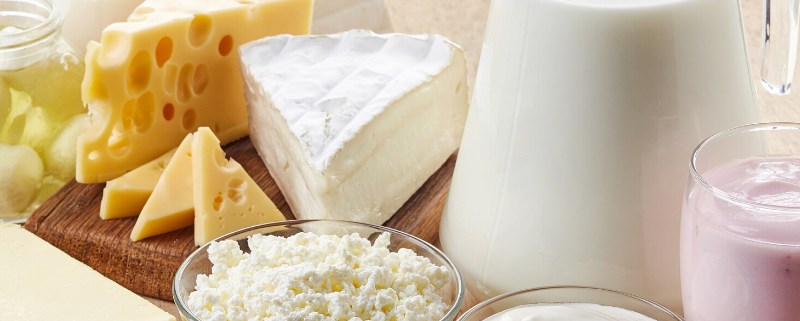9 Important Nutrients Found in Milk
 Did you know that June is National Dairy Month? You may be familiar with some of the health benefits associated with dairy from the abundant advertisements in the media. Dairy milk is filled with important proteins, calcium, potassium, phosphorus, vitamin A, vitamin D, vitamin B12, riboflavin, and niacin. These nutrients provide several health benefits.
Did you know that June is National Dairy Month? You may be familiar with some of the health benefits associated with dairy from the abundant advertisements in the media. Dairy milk is filled with important proteins, calcium, potassium, phosphorus, vitamin A, vitamin D, vitamin B12, riboflavin, and niacin. These nutrients provide several health benefits.
The USDA MyPlate recommends adults consume 2-3 cups of dairy each day. The various nutrients in dairy make it an important food for a healthful, varied diet.
Dairy milk is produced by non-human animals, such as cows, sheep, or goats. Dairy milk can be used to create even more food products like ice cream, yogurt, cheese, heavy cream, and butter. There are so many ways you can use dairy products in your cooking to get your recommended 2-3 cups of dairy per day.
The Health Benefits of Dairy Milk
The numerous nutrients found in dairy products are used by your body to carry out important functions. Dairy is a great source of a variety of vitamins and minerals. Here are just some of milk’s important nutrients and their functions:
- Protein is a macronutrient essential to your health. The amino acids in protein are the building blocks of muscle tissue and provide the body with energy.
- Calcium is important for building strong bones and teeth.
- Potassium is an electrolyte which the body uses to maintain healthy blood pressure levels.
- Phosphorus is an important mineral that keeps bones strong and help the body produce energy.
- Vitamin A helps keep the immune system alert and working properly. It also helps with preserving vision and maintaining good skin health.
- Vitamin D is needed to regulate calcium absorption as well as to keep bones sturdy and strong.
- Vitamin B12 is used to build health red blood cells and nerve tissue.
- Riboflavin (Vitamin B2) helps convert food into energy that your body can use.
- Niacin helps your body digest sugars and fats from the food you eat, such as that found in dairy.
The Varieties of Dairy Milk
There are many different varieties of dairy milk based on the way it is processed. Each variety of milk has its own nutrient profile and cooking properties. Here are some of the different varieties:
- Whole Milk contains 3.25% milkfat by weight, making it the full-fat version of dairy milk.
- 1% Low fat or 2% Reduced Fat Milk. The percentage of this label indicates the percentage of fat in the milk. Therefore, 1% low fat milk means the milkfat is 1 percent of the total weight of the milk, and 2% reduced fat milk means the milkfat is 2% of the total weight of the milk. Note, 2% milk is not considered low fat, it is reduced fat.
- Skim Milk is fat-free milk and still contains the 8 grams of high-quality protein dairy is known to have.
- Condensed Milk is milk that has been thickened by removing the water content.
- Evaporated Milk is milk that has had some of the water content removed by evaporation.
- Buttermilk is the leftover milk after butter churning. It’s often used in baking or as a drink.
While milk is a popular favorite for many, it is also one of the big eight allergens. Up to 4.9% of the population is allergic to milk, and an additional 65% of people are lactose intolerant. This can pose as a challenge as these individuals work to navigate their food choices safely. Fortunately, there are plenty of alternatives available from the plant-based milk market. Some of these varieties include soymilk, almond milk, cashew milk, oat milk, walnut milk, rice milk, and hemp milk.
Your Turn to Take Action: How will you celebrate National Dairy Month? Let me know in the comments below!


Leave a Reply
Want to join the discussion?Feel free to contribute!